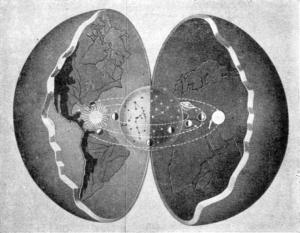
Even as I was writing three recent blog posts about flat-earthery—“Voliva!” discussing Wilbur Glenn Voliva, a flat-earther who hoped to be called to testify in the Scopes trial; “The Rim at the End of the World,” reviewing the flat-earth explanation of why the oceans don’t cascade off the planet; and “Taking the Voliva Challenge,” answering three questions that Voliva posed—I foresaw the likely complaint. A flat earth? How pedestrian! Why not discuss a seriously outré view about the shape of the Earth? And no, “Dr. Darwin’s Golden Secret,” examining a mysterious reference to Erasmus Darwin in a circular from John Cleves Symmes, the most famous hollow-earther, wasn’t intended to answer that demand. No, when I want a really cockamamie view about the shape of the Earth, I know where to look for it: Koreshanity.
Koreshanity was the brainchild of the euphoniously named Cyrus Reed Teed, born on October 18, 1839, near the village of Trout Creek, New York, and reared in the Utica area. He quit school at the age of eleven to work on the towpath of the Erie Canal. Leaving the towpath behind, he studied medicine with his uncle Samuel F. Teed in Utica and then in Brooklyn. He enlisted in the U.S. Army in 1862, but suffered a bout of sunstroke while marching, and was discharged in 1863. Completing his medical studies in 1868 at the Eclectic Medical College—a school that taught the use of botanical remedies and physical therapies—in New York City, he returned to the Utica area and joined his uncle’s medical practice. Who would have guessed that, in the early autumn of 1869, in his “electro-alchemical laboratory,” he would experience his illumination?
“It has been suggested,” David Standish wryly observes in Hollow Earth (2006), “that this illumination was nothing more than an accidental near-electrocution from the electricity he was so fond of fiddling with, a zzzolt! to the brain that, instead of killing him, produced this vision.” Be that as it may, it was a doozy, incorporating the discovery of the secret of converting matter to energy and back to matter again (which Teed aptly called “the philosopher’s stone”), investigating the possibility of immortality, hearing his own voice instructing him about his past lives, and a vision of God, in the form of a beautiful woman, who told Teed that she is the Father, the Son, and the Mother, all in one, and—if I read it correctly—proposed to have children (“the Sons of God”) by him. Oh, and there was also something about the shape of the Earth.
According to The Cellular Cosmogony (1898, but I’m using the 1905 edition), “In 1870, the Author of the Koreshan System of Universology”—that is, Teed, although by now his name is Koresh, the Hebrew version of the Greek name Cyrus—“upon the basis of the law of comparative analogy, announced the discovery of the cosmogonic form, which he then declared to be cellular, the surface of the earth being concave, with a curvature of about eight inches to the mile. This rate of curvation would give a diameter of eight thousand, and a circumference of twenty-five thousand miles.” The key word here is “concave.” For Koresh, the Earth is a hollow sphere, and we’re on the inside surface. “The world is therefore face to face with a radical astronomical revolution,” The Cellular Cosmogony explains, and you could hardly accuse it of understating the matter.
What reasons were given for accepting the inside-out Earth of Koreshanity? First, experiment. A large portion of The Cellular Cosmogony is filled with reports of surveys conducted by the Koreshan Geodetic Staff that show, “conclusively,” that the surface of the Earth is not convex—“It appears to be so because of optical illusions.” Second, the Bible. It so happens that “the Bible and Koreshan Science, their teachings being one and the same, are opposed to the prevailing scientific theories.” The Cellular Cosmogony contains a section citing chapter and verse for various claims, e.g., “The Scriptures refer in a striking manner to the earth’s concavity, indicating that its inner surface is habitable, and to the fact that we live on the inside instead of on the outside, as indicated in the Lord’s prayer: ‘Thy will be done in earth as it is in heaven’” (emphasis in original).
Unsurprisingly, there’s a fair amount of hostility toward modern astronomy, and the figure of Copernicus in particular, in The Cellular Cosmogony. I was mildly surprised to find hostility toward Darwin, too. From The Variation of Animals and Plants under Domestication (1868), Koresh quotes Darwin as saying, “In scientific investigations it is permitted to invent any hypothesis, and if it explains various large and independent classes of facts it rises to the rank of a well-grounded theory.” Promptly equating “hypothesis” with “guess” and ignoring the proviso about explanatory success, Koresh pounces: “Darwinism, as Darwin himself affirms, is predicated entirely upon ‘scientific’ guesses.” Koreshan Science, however, “predicates nothing upon guesswork; its first step ... is the correct establishment and proof of its premise.”
Yet Alfred Russel Wallace, the codiscoverer of evolution through natural selection, receives a friendly treatment, if under the disguise of “A. Russell Wallace.” Wallace’s Man’s Place in the Universe (1903) argued, on the basis of contemporary astronomy, for “one great and definite conclusion—that man, the culmination of conscious organic life, has been developed here only in the whole vast material universe we see around us.” Part of Wallace’s argument involves arguing for the spatial finitude of the universe, which, at least according to Koresh, “is an approach to the Koreshan conception.” Accordingly, he calls for “a few tributes of respect” to Wallace—as well as, apparently gratuitously, to Rudolf Virchow “for strenuously opposing the Darwinian theory of evolution.” More on Koresh and the inside-out earth to come in part 2.

